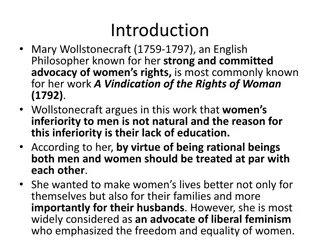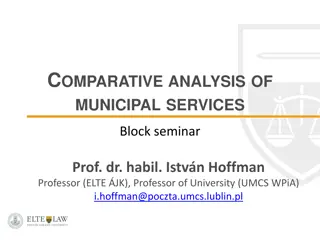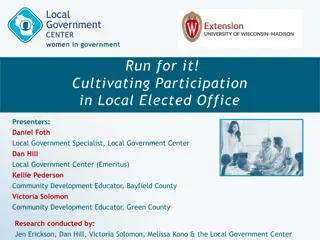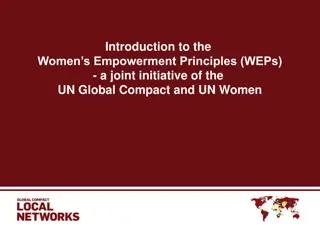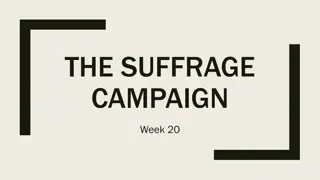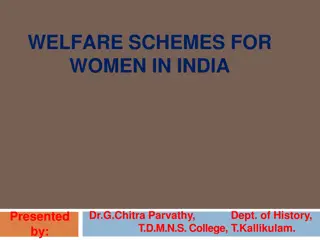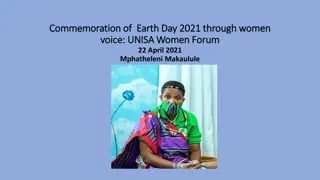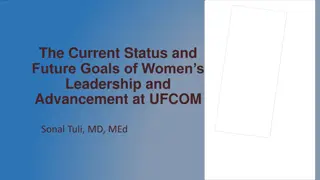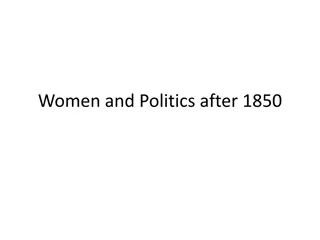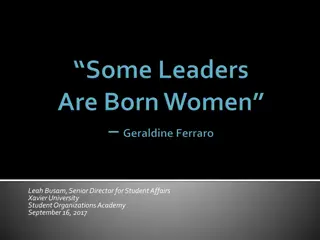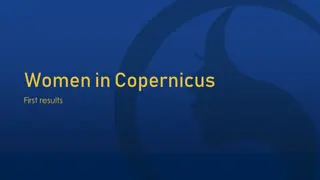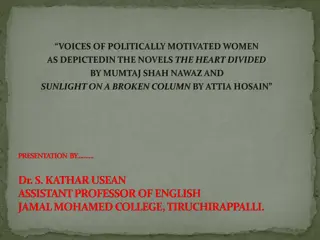Recognizing Women's Impact in Public Service and Government
National Women's History Month celebrates the contributions of women in public service and government, highlighting leaders like Isabel Gonzalez and Dorothy C. Stratton. Gonzalez fought for Puerto Rican citizenship rights, while Stratton led the US Coast Guard Women's Reserve during WWII, expanding opportunities for women in the military and beyond. These stories underscore the vital role women play in shaping history and inspiring future generations towards progress and equality.
Download Presentation

Please find below an Image/Link to download the presentation.
The content on the website is provided AS IS for your information and personal use only. It may not be sold, licensed, or shared on other websites without obtaining consent from the author.If you encounter any issues during the download, it is possible that the publisher has removed the file from their server.
You are allowed to download the files provided on this website for personal or commercial use, subject to the condition that they are used lawfully. All files are the property of their respective owners.
The content on the website is provided AS IS for your information and personal use only. It may not be sold, licensed, or shared on other websites without obtaining consent from the author.
E N D
Presentation Transcript
Womens History Month Writing Women Back Into History Honoring Women in Public Service and Government
The National Womens History Month honors women who have shaped America s history and its future through their public service and government leadership. Although often overlooked and undervalued, collectively they have dramatically influenced our public policy and the building of viable institutions and organizations. From championing basic human rights to ensuring access and equal opportunity for all Americans, they have led the way in establishing a stronger and more democratic country. Each of these public leaders succeeded against great odds. The diversity of their experiences demonstrates both the challenges and the opportunities women in public service have faced. Their ability to use the art of collaboration to create inclusive solutions and non- partisan policies, as well as their skill and determination, serve to inspire future generations. The tenacity of each Honoree underlines the fact that women from all cultural backgrounds in all levels of public service and government are essential in the continuing work of forming a more perfect union.
Isabel Gonzalez (1882-1971) fought to ensure full US citizenship rights for all Puerto Ricans. Gonz lez left Puerto Rico in 1902 to meet family and wed the father of her unborn child. While she was enroute, the US tightened immigration restrictions and upon arrival her ship was sent to Ellis Island. Labeled an alien and targeted as a ward of the state because of her pregnancy, Gonzalez entered detention. Her family vouched for her at multiple hearings, but the authorities refused to release her. Her uncle acquired a lawyer and seven weeks later Gonzales case was heard before the Circuit Court for the Southern District of NY. The court ruled against Gonz lez, affirming her status as an alien. The case of Gonz lez v Williams was heard before the US Supreme Court in 1903; the court ruled only partially in Gonz lez favor, finding that Puerto Ricans should not be treated as aliens, but not granting them full citizenship. Her case was the first time the Supreme Court considered the matter of residents of US territories having full citizenship. Gonz lez continued her campaign for all Puerto Ricans to gain US citizenship which was resolved in 1917 when Congress passed the Jones- Shafroth Act, granting all Puerto Ricans American citizenship.
Dorothy C. Stratton (1899-2006) was Director of SPARS (US Coast Guard Women s Reserve) during World War II. Prior to joining the military, Stratton was Purdue University s first Dean of Women (1933- 1942). She expanded female curriculum beyond Home Economics and female enrollment at Purdue nearly tripled. Stratton was the first woman to be accepted in the US Navy after President F. Roosevelt created a women s reserve program. She initially joined the WAVES (Women Accepted for Voluntary Emergency Service), but in November 1942, she transferred to the US Coast Guard and became the director of the Women s Reserve and developed the SPARS program. By 1944, 1 out of every 15 persons enlisted in the Coast Guard was a woman. After the war, Stratton became the Director of Personnel at the International Monetary Fund. She also became the National Executive Director of Girl Scouts of America.
In 2001, the Coast Guard Womens Leadership Association named the Captain Dorothy Stratton Leadership Award in her honor. In 2012, First Lady Michelle Obama commissioned a coast guard cutter in honor of Dorothy Stratton. It was the first time in history that a Legend- class National Security Cutter was named after a woman, and the first time that a first lady sponsored a coast guard or navy ship. Today, the Cutter Stratton protects America s shoreline
Oveta Culp Hobby (1905-1995) helped define womens roles during World War II. After receiving her law degree, she worked for the Texas House of Representatives and the city attorney of Houston. Her husband, William P. Hobby, was publisher of the Houston Post; Hobby helped run the Post before moving to Washington, DC to head the War Department s Women s Interest Section. In 1942, Hobby became the Director of the new Women s Army Auxiliary Corps, later the Women s Army Corps, under which over 150,000 women served. Challenging all gender norms, the Corps faced opposition from both the public and male service members, but as they freed up more men for combat the women quickly proved their worthiness. Colonel Hobby was awarded the Distinguished Service Medal in 1945. After the war she was appointed the first secretary of the Department of Health, Education, and Welfare, a position that she held until 1955. She returned to publishing and broadcasting, including working as the president and editor of the Houston Post and director of the Corporation for Public Broadcasting.
Daisy Bates (1912-1999) was a journalist and Civil Rights activist who facilitated the 1957 integration of public schools in Little Rock. Growing up in southern Arkansas, Bates experienced first hand poverty and discrimination within the segregated school system. Daisy and husband, L. C. Bates, ran a weekly newspaper called The Arkansas State Press. The newspaper focused on social and economic issues that affected the black residents of the state, and often reported incidents of police brutality. Because the Bates refused to censor the details of these brutalities, many white businesses boycotted advertising in their newspaper. In 1952, Daisy Bates was elected President of the Arkansas Branch of the NAACP. In that role she led the protest against the Little Rock School Board s plan for gradual integration. In 1957, Bates worked with the chosen nine African American students, guiding and advising them as they made their attempts to enter the school. In 1963, she was the only woman selected to speak at the March on Washington. She went on to work for the Democratic National Committee s voter education drive and for President Lyndon Johnson s anti-poverty programs.
Daisy Bates: Mr. Randolph, friends, the women of this country [inaudible] our pledge to you, to Martin Luther King, Roy Wilkins and all of you fighting for civil liberties that we will join hands with you as women of this country. Rosa Gregg, Vice President; Dorothy Height, the National Council of Negro Women; and the Delta Sigma Theta Sorority; the Methodist Church Women, all the women pledge that we will join hands with you. We will kneel-in; we will sit-in until we can eat in any corner in the United States. We will walk until we are free, until we can walk to any school and take our children to any school in the United States. And we will sit-on and we will kneel-in and we will lie-in if necessary until every Negro in America can vote. This we pledge to the women of America.
Ella Grasso (1919-1981) was a politician and champion of marginalized groups. Grasso s political career spanned over 45 years and she won all ten elections she ran in. Grasso first ran for elected office in 1952 and won a seat in the Connecticut General Assembly. Serving in the CT Assembly until 1959, she became the first woman elected Floor Leader in 1955. Elected CT Secretary of State in 1958, she was reelected twice and served in this role until 1970 when Grasso won election as a US Representative and served 2 terms in the US House of Representatives. Grasso then won election as CT Governor in 1974 and was reelected to a second term. Grasso resigned in 1980 after being diagnosed with terminal ovarian cancer. As governor Grasso had a commitment to create a more effective government, balance the budget, and adhere to the democratic process. Ella Grasso is remembered as a trailblazing woman and a champion of marginalized groups including minorities, women, young people, the elderly, and the working class.
Betty Mae Tiger Jumper (1923-2001) worked to better the livelihood and commemorate the traditions of the Seminoles. She worked to integrate modern medicine and ensure the endurance of traditions and oral history of the tribe. As a young girl, she entered the Indian Boarding school in Cherokee, NC. and was the first Florida Seminole to read and write English and graduate from high school. In 1967, after working as Vice Chair and with the encouragement of fellow tribal women, Tiger Jumper ran against three male opponents for the seat of Seminole Tribe of Florida Chairman and won, becoming the first elected female tribal chief in the US. During her tenure (1967- 1971) she created the United Southeastern Tribes (USET) coalition, which today consists of more than 26 tribes. In addition to her political work, Betty Mae encouraged Seminole oral history preservation. She founded the first Seminole newspaper, and used it as a way to publish and distribute Seminole stories. Betty Mae Tiger Jumper s work not only improved the well-being of thousands, but also helped ensure the legacy of her tribe.
Sister Mary Madonna Ashton, CSJ (1923 - ), Public Health Leader and Minnesota Commissioner of Health, has a distinguished career in public and private service. Sister Ashton worked in medical social work and hospital administration, serving as president and CEO at St. Mary s Hospital in Minneapolis from 1962-1982. She served as Minnesota Commissioner of Health from 1983 to 1991. Despite tremendous opposition (she was not a physician, she was a woman and a nun!) Sister Ashton successfully addressed smoking cessation and AIDS prevention and helped pass landmark legislation outlawing smoking in public places and on public property. Testifying for days against the tobacco industry, her success on behalf of the state of Minnesota started a nationwide movement.
Nancy Grace Roman (1925 ) is an astronomer and first women executive at the National Aeronautics and Space Administration (NASA). Roman is known as the Mother of Hubble for her contributions to establishing the Hubble Space Telescope. Throughout her career Roman has been an outspoken advocate for women in the sciences. Although discouraged by teachers at all levels who thought women were not suited to study science, Roman persevered and received a degree in astronomy from Swarthmore College and PhD in astronomy at the University of Chicago in 1949. Roman stayed at the University for six years, but left due to the limited opportunities for women. Roman worked at the Naval Research Laboratory before being hired by newly formed NASA in 1959 to create the organization s space astronomy program. Roman worked at NASA for 21 years followed by working as a consultant for companies contracted with NASA. She fully retired in 1997, and began extensive volunteer work including conducting science programs in underserved Washington, DC schools.
Nancy Grace Romans career was groundbreaking not only as a woman scientist, but also in her research discoveries and the programs she created. She discovered the first clues to the evolution of the Milky Way galaxy, mapped the sky at 67 centimeters, and helped improve the accuracy of measurements to the distance of the moon. At NASA Roman led a program that launched over 20 satellites and 3 orbiting solar observatories. Roman laid the early groundwork for the Hubble Space Telescope, setting the program s structure, recruiting astronomers, and lobbying Congress to fund it. Roman s many awards and honors include The Federal Woman s Award (1962), NASA s Exceptional Scientific Achievement Award (1969), and a NASA fellowship in astrophysics is named in her honor.
Bernice Bunny Sandler (1928 ) is a womens rights activist, known for her work fighting sexual harassment and discrimination on college campuses. Labeled the Godmother of Title IX, Sandler led efforts for the legislation s enactment and implementation. Despite holding a doctorate degree, Sandler was unable to obtain a full-time faculty position because of the institutional sexism facing women in academia. Although Title VII of the Civil Rights Act of 1964 prohibited discrimination in employment based on sex, it excluded educational institutions. Determined to fight collegiate sexism, Dr. Sandler used an Executive Order, issued in 1968 by President Lyndon Johnson prohibiting sex discrimination by federal contractors, to file the first federal sex discrimination lawsuits against every college with federal contracts.
Congresswoman Edith Green assembled the first Congressional hearings on sex discrimination in education and employed Sandler as an expert. From there the idea for a law banning sex discrimination in federally- funded education programs was born. Cosponsored by Congresswoman Patsy Mink (D-Hawaii), Title IX passed two years later and was signed into law by President Richard Nixon in 1972. Title IX immediately ended overt sex discrimination in educational admissions and hiring practices. But in 1974, Sandler and others realized that the law could also cover discrimination in scholastic athletics, ending a system in which women s programs were rarely funded or even offered. The law has more recently been used to better address sexual violence on campus. Title IX states (in part): No Title IX states (in part): No person in the United States person in the United States shall, on the basis of sex, be shall, on the basis of sex, be excluded from participation excluded from participation in, be denied the benefits of, or in, be denied the benefits of, or be subjected to discrimination be subjected to discrimination under any education program under any education program or activity receiving federal or activity receiving federal financial assistance. financial assistance.
Sonia Pressman Fuentes (1928 ) is a lawyer, author, speaker and pioneering feminist leader who fought for women s equality in the work force and helped initiate the Second Wave of the women s rights movement. Fuentes was the first woman attorney to work in the Office of the General Counsel at the Equal Employment Opportunity Commission (EEOC). While there, she stood for the aggressive enforcement of the gender discrimination prohibitions of Title VII of the Civil Rights Act of 1964. Fuentes was one of the founders of the National Organization for Women (NOW) and charter member of the advocacy group Federally Employed Women (FEW). Fuentes has also served on the advisory committees of the Veteran Feminists of America (VFA) and the Longboat Key Education Center.
Barbara Mikulski (1936-) is the Senior Democratic Senator from Maryland. Mikulski has championed equal pay, a woman s right to choose, health care and medical research, and child-care for low-income families. Mikulski began her career working with at risk children and seniors and evolved into community activism when she organized support against a 16 lane highway through Baltimore. Mikulski won her first local election in 1971 and first congressional campaign in 1976. In 1986, Mikulski ran for Senate, becoming the first Democratic woman Senator elected. She was re elected in 1992, 1998, 2004, and 2010. Mikulski is the Dean of the Women serving as a mentor to other women Senators and working to form bipartisan coalitions. On January 5, 2011, Mikulski became the longest serving woman Senator in US history and on March 17, 2012 she became the longest serving woman in the US Congress. In November 2015, Mikulski received the Presidential Medal of Freedom.
Judy Hart (1941- ) is a civic activist whose career with the US National Park Service has helped legitimize and raise awareness of women s history in America. Hart began her career with the NPS in 1976, working both in Washington, DC and the Boston area. She helped establish the Marsh Billings National Historical Park, the Mary McLeod Bethune National Historic Site, the Petroglyphs National Monument, and others. Hart worked to establish the Women s Rights National Historical Park, becoming the first superintendent in 1980. Before retiring in 2005, Hart became the first superintendent of the Rosie the Riveter/World War II Home Front National Park in Richmond, CA, having been instrumental in making the park a reality. Through Judy Hart s efforts, the stories and experiences of women across the country are recognized and honored by the National Park system.
Suzan Shown Harjo (1945 ) is a Native American activist descended from Cheyenne and Hodulgee Muscogee Nations; her accomplishments include helping Native peoples regain more than one million acres of tribal lands. Harjo s activism dates to the 1960s when she co-produced the nation s first Native American news radio show and began working with the Museum of the American Indian in NY, where she helped return sacred garments to tribes and helped the museum change its policies to more respectfully present Native artifacts. In the 1970s Harjo and her husband moved to Washington, DC where, she was appointed Congressional liaison for Indian Affairs by President Jimmy Carter. Her tireless lobbying efforts led to the 1978 passage of the American Indian Religious Freedom Act. From 1984 to 1989, Harjo served as Executive Director of the National Congress of American Indians, where she continued to fight for the return of Native lands. She also successfully secured increases in appropriations toward Native American education programs.
Throughout her career, Harjo has spoken out against negative and stereotypical portrayals of Native Americans in movies and on television. A leader in efforts to remove negative Native names and images from sports teams; by 2013 her public campaigns had succeeded in more than two-thirds of teams moving away from Indian mascots. In 1984, Harjo founded the Morning Star Institute in memory of her late husband. Still serving as the organization s president today, Harjo continues to promote sacred land claims and traditional cultural rights. In 2014, Suzan Shown Harjo received the Presidential Medal of Freedom from President Barack Obama.
Karen Narasaki (1958-) is a lawyer, lobbyist, and leader who dedicates her career to issues of Asian American equality. Her work focuses on voting rights, affirmative action, family immigration, media representation, and hate crimes prevention. Narasaki served as a representative for the Japanese American Civil Rights League and as President and Executive Director of the Asian American Justice League. Her leadership led to passage of stronger hate crimes and voting rights laws and helped defeat legislation that eroded the family immigration system. She also ensured a more accurate counting of Asian American and Pacific Islanders in the US Census and their access to affirmative action programs. In 2014, President Obama appointed Narasaki to serve on the US Commission on Civil Rights. Narasaki s efforts have worked to strengthen ties with African American, Latino, Native American, and other minority communities.
Nadine Smith (1965-) is a lobbyist, activist, and national leader in LGBT rights. She served as one of four national co-chairs on the 1993 March on Washington, coordinating national and international media coverage, and took part in the historic, first-ever meeting between LGBT leaders and President Bill Clinton, in the White House. Smith served four terms as co-chair of the Equality Federation and served as a member of the Democratic National Committee. Smith led advocacy efforts in Florida at the state level at a time of unprecedented attacks on the LGBT community. Smith is an outspoken advocate for hate crimes and bullying legislation. In 2008, Equality Florida s efforts led to passage of a state anti-bullying law that spurred school districts across Florida to add sexual orientation and gender identity to their bullying policies. She is executive Director of Equality Florida. Smith has been recognized for her national and state leadership by organizations including the National Gay and Lesbian Task Force, the Human Rights Campaign, the National Center for Lesbian Rights, and the National Black Lesbian and Gay Leadership Forum.
Inez Milholland Boissevain (1886-1916) gave her life working for the Woman Suffrage movement. Milholland was a lawyer who also fought for the rights of working class women, spoke out for racial equality, and worked for prison reform. Milholland became active in the Suffrage movement at Vassar where her suffrage meetings were eventually banned from campus. For six years, she was involved in the drive for Votes for Women in New York, memorably lobbying state lawmakers and leading annual suffrage parades up Fifth Avenue. In 1913, she helped plan the Woman Suffrage Parade in Washington, DC, and she famously led the parade wearing a cape and crown atop a white horse.
In 1916, she accepted the role of Flying Envoy on a speaking tour of the western states. Across the West she addressed women with passion and conviction; Now, for the first time in our history, women have the power to enforce their demands, and the weapon with which to fight for woman s liberation. In October, after dramatically asking, Mr. President, how long must women wait for liberty, she collapsed before a large audience in Los Angeles, CA. She died a month later of pernicious anemia. Fellow suffragists recognized that her love of democracy and devotion to women made her a martyr for the cause.
Sources: http://www.nwhp.org/womens-history-month/2017-honoree-nominations/ https://en.wikipedia.org/wiki/
The study of history and political science provides enhanced understanding of society, increases communication skills, and teaches critical thinking. These, and other benefits of a liberal arts education, bring confidence and increased enjoyment in every area of life by broadening the students intellectual experience. The History & Political Science Department serves Andrews students in several ways. It provides general educational courses required for all students and offers degree programs for those interested in further study of American and European history, political science, or social studies. Faculty in the department aid students in understanding the relationship of the past and present and demonstrate how local, national, and international political processes affect and respond to events. All teachers approach their subjects from an explicit, biblically based, Christian perspective. https://www.andrews.edu/cas/history/
A major in History from Andrews University equips students with knowledge and skills for success in a wide range of areas. Students understand the past and its relationship to the present through a variety of American, European, and non- western history courses, training in a foreign language, hands-on experience in historical research, and an introduction to historical philosophy and theory. Our degree prepares students for careers in teaching, research, law, and for graduate work in a wide range of professional and academic areas. In addition, it encourages the moral, intellectual, civic, social, and spiritual maturity to accompany a life well- lived. A Political Science major from AU equips students with unique knowledge and skills that find practical solutions to some of the world's most urgent social, economic and political problems. It prepares students for careers in teaching, government and politics, law, and for graduate student in a wide range of professional and academic areas. In preparing students for a specific profession, a political science major teaches lessons in citizenship and statesmanship and seeks to encourage moral, intellectual, civic, social, and spiritual maturity to accompany a life well-lived. The discipline of Political Science also teaches students to critically assess a host of difficult problems and aims at finding. Our Social Studies degree from AU is an interdisciplinary program that prepares students for teaching elementary and secondary education.




